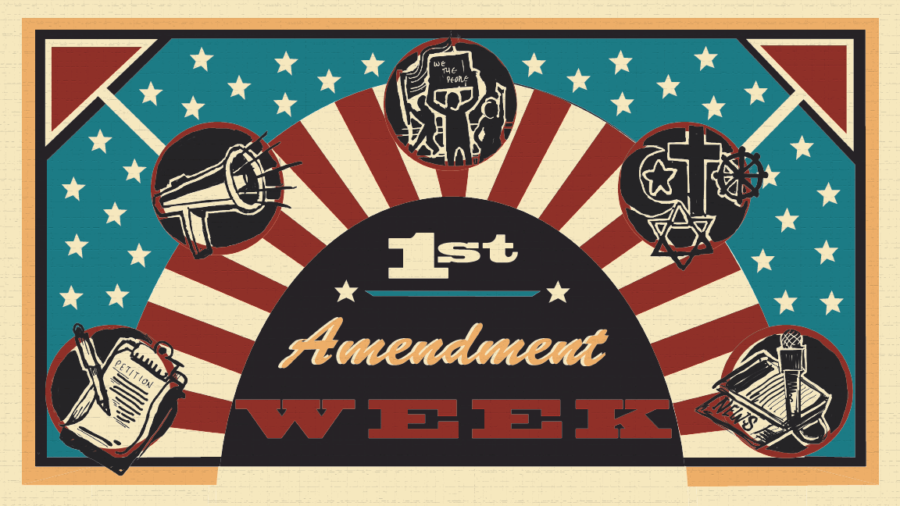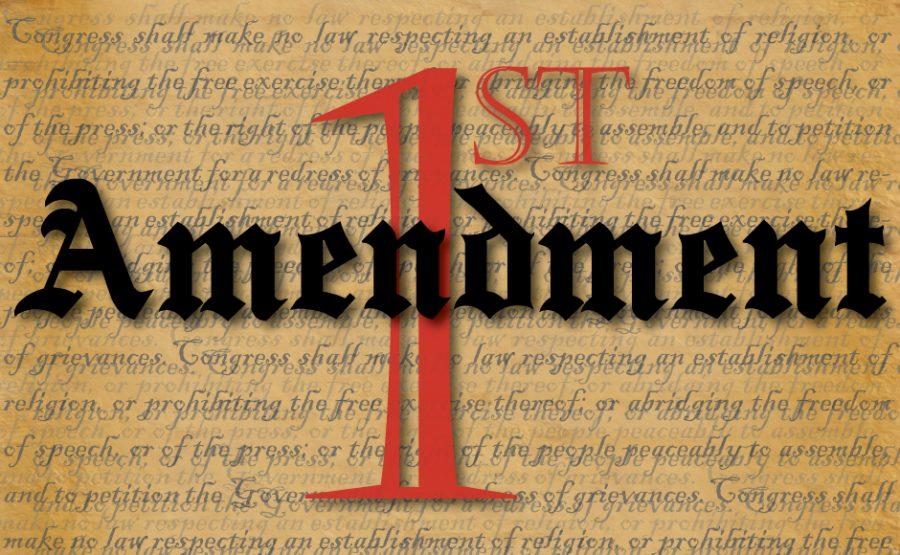Understanding the Five Freedoms of The First Amendment
April 26, 2022
Within our country, we are given five freedoms that are not available to others. These five freedoms are freedom of religion, speech, press, assembly, and petition. These five freedoms come from the First Amendment of the U.S. Constitution. Throughout our history and during government classes in school, students are taught these freedoms and cases involving the infringement of them. However, students graduate over time and forget about these five freedoms that they have. According to Freedom Forum, about one in five (18%) couldn’t name one freedom in the First Amendment. Of those who could name at least one, 78% could identify free speech, followed by 49% naming religion, 39% assembly, 34% free press and 14% the right of petition. Just 9% correctly identified all five. This shows that people are not understanding the importance of these five freedoms. To solve this, I will discuss recent Supreme Court cases that involve the infringement of these rights.
The first case involves the infringement concerning the freedom of speech in June of 2015. According to Freedom Forum, free speech allows people to criticize the government without fear of being punished. This case is titled Elonis V. U.S., and it involves a man named Anthony Elonis. According to UNITED STATES COURTS, Elonis threatened many people over Facebook, which included his ex-wife, co-workers, a kindergarten class, the local police, and an FBI agent. Elonis believed his freedom of speech was being violated because he did not mean to threaten anyone. He expressed how he had lost his wife and job and was trying to be a rapper with artistic flow. According to SCOTUS blog, Elonis argued that he hadn’t intended to threaten anyone at all but was instead simply imitating lyrics such as those of rapper Eminem.
According to UNITED STATES COURTS, Elonis was dealing with his wife and family leaving him and losing his job through this rapping. He asked the court to dismiss the charges since they were not true threats. He made these comments seem like they were not threats through parodying YouTube videos. According to UNITED STATES COURTS, he posted a disclaimer stating, “This is not a threat.” However, there were two important cases reviewed. SCOTUS blog provides the two cases, one of whom told a convenience store clerk that he, “was going to end up finding [his] father,” a detective in the local sheriff’s office, “dead in a ditch,” while the other told his mother that he would burn down her house and kill her.
UNITED STATES COURTS states that the trial court denied his motion to dismiss the case. This was because a threat can still be seen as a threat if others view it as a threat. Elonis was sentenced to forty-four months of imprisonment and three years of supervised release. The Supreme Court agreed to hear the case. Chief Justice Roberts delivered the 8-1 opinion for the majority. According to Oyez, the court held that the prosecution needed to show that Elonis intended the posts to be threats, and therefore that there was a subjective intent to threaten.
I had a BVU student named Kyle Miller provide his insight for this case. Before I had him read the case, I asked if he could name the five freedoms of the First Amendment. “Freedom of speech, freedom of religion, and freedom of assembly. That’s all I know.” He was unable to name the freedom of petition and the freedom of press. I then asked for his insight about this case. “After reading it I would agree that it was freedom of speech. I could see how they took it as a threat. However, if he claims that it was not a threat and posted a disclaimer that it was not a threat; then it should not be taken as one. This case has the right to be a Supreme Court case because it depends on what he was saying. If he did say some pretty harsh things that could be seen as threats, then I understand how he got the sentence that he did. I also think that the Supreme court agreeing to hear it was a good idea. This was also a fair verdict. Again, he said it was not a threat and you do have the freedom to say what you want as long as it does not put anyone in danger.”
The second supreme court case involves the infringement of freedom of religion in October of 2020. According to Freedom Forum, the freedom of religion is American’s right to worship or choose not to. This case is titled Tanzin V. Tanvir and involved three Muslim men named Muhammad Tanvir, Jameel Algibhah, and Naveed Shinwari. According to SCOTUS blog, the three men sued the FBI after they refused to become FBI informants. Since the men refused to become FBI informants, they were placed onto the “no fly” list. SCOTUS blog states that the “no fly” list barred them from boarding commercial flights in the United States. The Muslim men sued the FBI because the placement on this “no fly list” violated the Religious Freedom Restoration Act. SCOTUS blog defines this as a federal law that prohibits the government from placing a “substantial burden” on an individual’s exercise of religion unless the burden advances a compelling government interest and there is not a less restrictive way to achieve that interest. The three men asked to be removed from the “no fly” list and receive compensation for the violation of their rights. This compensation included money for airline tickets that they previously could not use. It also included income that they lost when they could not take advantage of job opportunities.
SCOTUS blog states that the men were allowed to fly by the Department of Homeland Security. However, they were not allowed financial relief. This is because the Religious Freedom Restoration Act did not allow the men to sue the FBI agents for money damages. Then this went to the second circuit of the U.S. Court of Appeals reversed this ruling. This prompted the FBI agents to go to the Supreme Court. SCOTUS blog discusses Justice Clarence Thomas’s opinion. Justice Clarence Thomas upheld the 2nd Circuit’s ruling because of what the Religious Freedom Restoration Act allowed. Which allowed an individual whose exercise of religion had been burdened to “obtain appropriate relief against a government.” Thomas explained that this allows someone who has been injured to sue government officials in their personal capacities.
For this case, I had BVU student Cameron Kaltschnee provide his insight. I began by first asking if he could name the five freedoms of the First Amendment. “Freedom of speech, freedom of religion, freedom of assembly, and freedom of press. I feel like it’s like freedom of press?” He was unable to state the freedom of petition. Next, he provided his insight into the case. “I do think that the government did infringe on their rights by putting them on the no-fly list because they didn’t become informants. This is against their religion to do so, and it does violate the First Amendment. I do not think that they were using the correct law to get their money back. I’m not saying that they should have gotten their money back, I just do not think they did it correctly. That is why I think that this particular case could have been something else. I’m not sure what it would have been, maybe like a civil suit. The government was initially in the wrong, but once the defendants pushed too far, they became the ones in the wrong.”
The final supreme court case involves the infringement of petition. According to FREEDOM FORUM, the right to petition protects our right to ask the government to fix a wrong or change a policy. The case involving this infringement is Biden v. Knight First Amendment Institute at Columbia University. This case occurred in 2021 and it involved Donald Trump and the Knight Institute at Columbia University. THE FIRST AMENDMENT ENCYCLOPEDIA states that Donald Trump’s favorite way to communicate was through tweets published on Twitter. Individuals that use Twitter know that they can respond to any published tweets. However, people cannot respond to a published tweet if they are blocked from the publisher. The Knight Institute at Columbia University saw that President Trump had blocked them and sued. THE FIRST AMENDMENT ENCYCLOPEDIA states that they sued Trump because the medium constituted a First Amendment public forum and that Trump had interfered with the First Amendment right of petition. A U.S District Court and a 2nd U.S Court of Appeals agreed to this being an infringement of petition. Despite this agreement, the case was appealed to the Supreme Court.
The Supreme Court decided to vacate the decision. Cornell Law School defines vacate as, “to set aside or annual a previous judgement or order.” The Supreme Court also decided that the case was moot. This was because Trump was no longer President and banned on twitter. Cornell Law School states that a case is moot because legal actions cannot be brought or continued after the matter at issue has been resolved, leaving no live dispute for a court to resolve. THE FIRST AMENDMENT ENCYCLOPEDIA stated that Twitter’s owners had banned Trump in the wakes of attacks on the U.S. Capitol.
Greg Tystahl, a BVU student, provided his insights into this case. Like the previous two students, I first ask him if he can name the five freedoms of the First Amendment. “I remember three. Freedom of the press, freedom of religion, and freedom of speech. I’m blanking on the other two.” After this, he provided his thoughts on the case. “I thought this case was a little weird. In terms of importance, it’s kind of on the low end. I understand where they were coming from with the freedom of petition and how it is his favorite medium. However, I feel like they still could have reached him through other means because he was the President, and he has assemblies. I do not think that the verdict was fair. I get where they are coming from, but there is definitely different ways to communicate with the President. Yes, he did cut off one avenue, but he did not completely stop them. They could have used any other forms of social media. This should not have been a Supreme Court case.”
These three Supreme Court cases are important because they involve the freedom of speech, religion, and petition. These cases also show that not everyone that goes to the Supreme Court will win their cases. This is important to note because someone may believe their rights are being infringed, but they will not automatically win their case just because of the First Amendment and the rights it protects. If more people are aware of these cases, they will become more knowledgeable about cases that they are not taught within high school or college. They will also see how people will always want to fight for their five freedoms under the First Amendment. This willingness to fight should light a spark in the readers to value their five freedoms more than they already do.







